
Monsters
Ogre - Rust Monster
OGRE
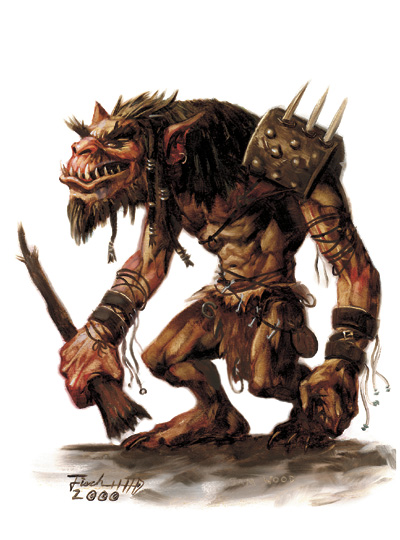 Large Giant Hit
Dice: 4d8+11 (29 hp) Initiative:
–1 Speed: 30 ft. in hide
armor (6
squares); base speed 40 ft. Armor
Class: 16 (–1 size, –1 Dex,
+5 natural, +3 hide armor), touch 8, flat-footed 16 Base Attack/Grapple: +3/+12 Attack: Greatclub +8 melee
(2d8+7) or javelin +1 ranged (1d8+5) Full
Attack: Greatclub +8 melee
(2d8+7) or javelin +1 ranged (1d8+5) Space/Reach:
10 ft./10 ft. Special Attacks: —
Special Qualities: Darkvision 60
ft., low-light vision Saves:
Fort +6, Ref +0, Will +1 Abilities:
Str 21, Dex 8, Con 15,
Int 6, Wis 10, Cha 7 Skills: Climb
+5, Listen +2, Spot
+2 Feats: Toughness, Weapon
Focus
(greatclub) Environment:
Temperate hills
(Merrow: Temperate aquatic) Organization:
Solitary, pair,
gang (3–4), or band (5–8) Challenge
Rating: 3 Treasure: Standard
Alignment: Usually chaotic evil
Advancement: By character class
Level Adjustment: +2
Large Giant Hit
Dice: 4d8+11 (29 hp) Initiative:
–1 Speed: 30 ft. in hide
armor (6
squares); base speed 40 ft. Armor
Class: 16 (–1 size, –1 Dex,
+5 natural, +3 hide armor), touch 8, flat-footed 16 Base Attack/Grapple: +3/+12 Attack: Greatclub +8 melee
(2d8+7) or javelin +1 ranged (1d8+5) Full
Attack: Greatclub +8 melee
(2d8+7) or javelin +1 ranged (1d8+5) Space/Reach:
10 ft./10 ft. Special Attacks: —
Special Qualities: Darkvision 60
ft., low-light vision Saves:
Fort +6, Ref +0, Will +1 Abilities:
Str 21, Dex 8, Con 15,
Int 6, Wis 10, Cha 7 Skills: Climb
+5, Listen +2, Spot
+2 Feats: Toughness, Weapon
Focus
(greatclub) Environment:
Temperate hills
(Merrow: Temperate aquatic) Organization:
Solitary, pair,
gang (3–4), or band (5–8) Challenge
Rating: 3 Treasure: Standard
Alignment: Usually chaotic evil
Advancement: By character class
Level Adjustment: +2
Adult ogres stand 9 to 10 feet tall and weigh 600 to 650 pounds. Their skin color ranges from dull yellow to dull brown. Their clothing consists of poorly cured furs and hides, which add to their naturally repellent odor.
Ogres speak Giant, and those specimens who boast Intelligence scores of at least 10 also speak Common.
Combat
Ogres favor overwhelming odds, sneak attacks, and ambushes over a fair fight. They are intelligent enough to fire ranged weapons first to soften up their foes before closing, but ogre gangs and bands fight as unorganized individuals.
MERROW
These cousins of the ogre have the aquatic subtype. They dwell in freshwater lakes and rivers. They have a base land speed of 30 feet and a swim speed of 40 feet and are found only in aquatic environments. Instead of the typical ogre’s greatclub, they prefer to use longspears in melee (attack +8 melee, damage 1d8+7).
OGRES AS CHARACTERS
Ogre characters possess the following racial traits.
— +10 Strength, –2 Dexterity, +4 Constitution, –4 Intelligence, –4 Charisma.
—Large size. –1 penalty to Armor Class, –1 penalty on attack rolls, –4 penalty on Hide checks, +4 bonus on grapple checks, lifting and carrying limits double those of Medium characters.
—Space/Reach: 10 feet/10 feet.
—An ogre’s base land speed is 40 feet.
—Darkvision out to 60 feet.
—Racial Hit Dice: An ogre begins with four levels of giant, which provide 4d8 Hit Dice, a base attack bonus of +3, and base saving throw bonuses of Fort +4, Ref +1, and Will +1.
—Racial Skills: An ogre’s giant levels give it skill points equal to 7 x (2 + Int modifier, minimum 1). Its class skills are Climb, Listen, and Spot.
—Racial Feats: An ogre’s giant levels give it two feats.
—Weapon and Armor Proficiency: An ogre is automatically proficient with simple weapons, martial weapons, light and medium armor, and shields.
— +5 natural armor bonus.
—Automatic Languages: Common, Giant. Bonus Languages: Dwarven, Orc, Goblin, Terran.
—Favored Class: Barbarian.
—Level adjustment +2.
OGRE MAGE
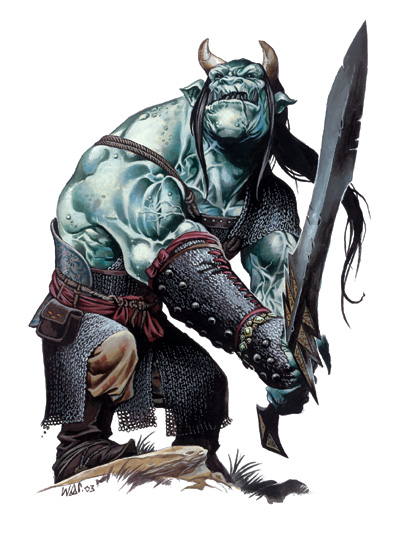 Large Giant Hit
Dice: 5d8+15 (37 hp) Initiative:
+4 Speed: 40 ft. (8 squares),
fly 40
ft. (good) Armor Class: 18 (–1
size, +5
natural, +4 chain shirt), touch 9, flat-footed 18 Base Attack/Grapple: +3/+12 Attack: Greatsword +7 melee
(3d6+7/19–20) or longbow +2 ranged (2d6/x3) Full Attack: Greatsword +7 melee
(3d6+7/19–20) or longbow +2 ranged (2d6/x3) Space/Reach: 10 ft./10 ft. Special Attacks: Spell-like
abilities Special Qualities:
Darkvision 90
ft., low-light vision, regeneration 5, spell resistance 19 Saves: Fort +7, Ref +1, Will +3 Abilities: Str 21, Dex 10, Con
17, Int 14, Wis 14, Cha 17 Skills:
Concentration +11, Listen
+10, Spellcraft +10, Spot +10 Feats:
Combat Expertise, Improved
Initiative Environment: Cold
hills Organization: Solitary,
pair, or
troupe (1–2 plus 2–4 ogres) Challenge
Rating: 8 Treasure: Double
standard Alignment: Usually
lawful evil Advancement: By
character class Level Adjustment:
+7
Large Giant Hit
Dice: 5d8+15 (37 hp) Initiative:
+4 Speed: 40 ft. (8 squares),
fly 40
ft. (good) Armor Class: 18 (–1
size, +5
natural, +4 chain shirt), touch 9, flat-footed 18 Base Attack/Grapple: +3/+12 Attack: Greatsword +7 melee
(3d6+7/19–20) or longbow +2 ranged (2d6/x3) Full Attack: Greatsword +7 melee
(3d6+7/19–20) or longbow +2 ranged (2d6/x3) Space/Reach: 10 ft./10 ft. Special Attacks: Spell-like
abilities Special Qualities:
Darkvision 90
ft., low-light vision, regeneration 5, spell resistance 19 Saves: Fort +7, Ref +1, Will +3 Abilities: Str 21, Dex 10, Con
17, Int 14, Wis 14, Cha 17 Skills:
Concentration +11, Listen
+10, Spellcraft +10, Spot +10 Feats:
Combat Expertise, Improved
Initiative Environment: Cold
hills Organization: Solitary,
pair, or
troupe (1–2 plus 2–4 ogres) Challenge
Rating: 8 Treasure: Double
standard Alignment: Usually
lawful evil Advancement: By
character class Level Adjustment:
+7
The ogre mage is a more intelligent and dangerous variety of its mundane cousin.
An ogre mage stands about 10 feet tall and weighs up to 700 pounds. Its skin varies in color from light green to light blue, and its hair is black or very dark brown. Ogre mages favor loose, comfortable clothing and lightweight armor.
Ogre mages speak Giant and Common.
Combat
Ogre mages rely on their spell-like abilities, resorting to physical combat only when necessary. When faced with obviously superior forces, they prefer to retreat using gaseous form rather than fight a losing battle.
Spell-Like Abilities: At will—darkness, invisibility; 1/day— charm person (DC 14), cone of cold (DC 18), gaseous form, polymorph, sleep (DC 14). Caster level 9th. The save DCs are Charisma-based.
Flight (Su): An ogre mage can cease or resume flight as a free action. While using gaseous form it can fly at its normal speed and has perfect maneuverability.
Regeneration (Ex): Fire and acid deal normal damage to an ogre mage.
An ogre mage that loses a limb or body part can reattach it by holding the severed member to the stump. Reattachment takes 1 minute. If the head or some other vital organ is severed, it must be reattached within 10 minutes or the creature dies. An ogre mage cannot regrow lost body parts.
OGRE MAGES AS CHARACTERS
Ogre mage characters possess the following racial traits.
— +10 Strength, +6 Constitution, +4 Intelligence, +4 Wisdom, +6 Charisma.
—Large size. –1 penalty to Armor Class, –1 penalty on attack rolls, –4 penalty on Hide checks, +4 bonus on grapple checks, lifting and carrying limits double those of Medium characters.
—Space/Reach: 10 feet/10 feet.
—An ogre mage’s base land speed is 40 feet. It also has a fly speed of 40 feet (good).
—Darkvision: Ogre mages can see in the dark up to 60 feet.
—Racial Hit Dice: An ogre mage begins with five levels of giant, which provide 5d8 Hit Dice, a base attack bonus of +3, and base saving throw bonuses of Fort +4, Ref +1, and Will +1.
—Racial Skills: An ogre mage’s giant levels give it skill points equal to 8 x (2 + Int modifier [minimum 1]). Its class skills are Concentration, Listen, Spellcraft, and Spot.
—Racial Feats: An ogre mage’s giant levels give it two feats.
— +5 natural armor bonus.
—Special Attacks (see above): Spell-like abilities.
—Special Qualities (see above): Regeneration 5, spell resistance 19.
—Automatic Languages: Common, Giant. Bonus Languages: Dwarven, Goblin, Infernal, Orc.
—Favored Class: Sorcerer.
—Level adjustment +7.
OOZE
Oozes are amorphous creatures that live only to eat. They inhabit underground areas throughout the world, scouring caverns, ruins, and dungeons in search of organic matter—living or dead.
COMBAT
Oozes attack any creatures they encounter. They lash out with pseudopods or simply engulf opponents with their bodies, which secrete acids that help them catch or digest their prey.
Blindsight (Ex): An ooze’s entire body is a primitive sensory organ that can ascertain prey by scent and vibration within 60 feet.
BLACK PUDDING
Huge Ooze Hit Dice: 10d10+60 (115 hp) Initiative: –5 Speed: 20 ft. (4 squares), climb 20 ft. Armor Class: 3 (–2 size, –5 Dex), touch 3, flat-footed 3 Base Attack/Grapple: +7/+18 Attack: Slam +8 melee (2d6+4 plus 2d6 acid) Full Attack: Slam +8 melee (2d6+4 plus 2d6 acid) Space/Reach: 15 ft./10 ft. Special Attacks: Acid, constrict 2d6+4 plus 2d6 acid, improved grab Special Qualities: Blindsight 60 ft., split, ooze traits Saves: Fort +9, Ref –2, Will –2 Abilities: Str 17, Dex 1, Con 22, Int —, Wis 1, Cha 1 Skills: Climb +11 Feats: — Environment: Underground Organization: Solitary Challenge Rating: 7 Treasure: None Alignment: Always neutral Advancement: 11–15 HD (Huge); 16–30 HD (Gargantuan) Level Adjustment: —The typical black pudding measures 15 feet across and 2 feet thick. It weighs about 18,000 pounds.
Combat
A black pudding attacks by grabbing and squeezing their prey.
Acid (Ex): The creature secretes a digestive acid that dissolves organic material and metal quickly, but does not affect stone. Any melee hit or constrict attack deals acid damage, and the opponent’s armor and clothing dissolve and become useless immediately unless they succeed on DC 21 Reflex saves. A metal or wooden weapon that strikes a black pudding also dissolves immediately unless it succeeds on a DC 21 Reflex save. The save DCs are Constitution-based.
The pudding’s acidic touch deals 21 points of damage per round to wooden or metal objects, but the ooze must remain in contact with the object for 1 full round to deal this damage.
Constrict (Ex): A black pudding deals automatic slam and acid damage with a successful grapple check. The opponent’s clothing and armor take a –4 penalty on Reflex saves against the acid.
Improved Grab (Ex): To use this ability, a black pudding must hit with its slam attack. It can then attempt to start a grapple as a free action without provoking an attack of opportunity. If it wins the grapple check, it establishes a hold and can constrict.
Split (Ex): Slashing and piercing weapons deal no damage to a black pudding. Instead the creature splits into two identical puddings, each with half of the original’s current hit points (round down). A pudding with 10 hit points or less cannot be further split and dies if reduced to 0 hit points.
Skills: A black pudding has a +8 racial bonus on Climb checks and can always choose to take 10 on a Climb check, even if rushed or threatened.
GELATINOUS CUBE
 Huge Ooze Hit
Dice: 4d10+32 (54 hp) Initiative:
–5 Speed: 15 ft. (3 squares)
Armor Class: 3 (–2 size, –5 Dex),
touch 3, flat-footed 3 Base
Attack/Grapple: +3/+11 Attack:
Slam +1 melee (1d6 plus
1d6 acid) Full Attack: Slam +1
melee (1d6
plus 1d6 acid) Space/Reach: 15
ft./10 ft. Special Attacks:
Acid, engulf,
paralysis Special Qualities:
Blindsight 60
ft., immunity to electricity, ooze traits, transparent Saves: Fort +9, Ref –4, Will –4 Abilities: Str 10, Dex 1, Con 26,
Int —, Wis 1, Cha 1 Skills: —
Feats: — Environment: Underground Organization: Solitary Challenge Rating: 3 Treasure: 1/10th coins, 50% goods
(no nonmetal or nonstone), 50% items (no nonmetal or nonstone) Alignment: Always neutral Advancement: 5–12 HD (Huge);
13–24 HD (Gargantuan) Level
Adjustment: —
Huge Ooze Hit
Dice: 4d10+32 (54 hp) Initiative:
–5 Speed: 15 ft. (3 squares)
Armor Class: 3 (–2 size, –5 Dex),
touch 3, flat-footed 3 Base
Attack/Grapple: +3/+11 Attack:
Slam +1 melee (1d6 plus
1d6 acid) Full Attack: Slam +1
melee (1d6
plus 1d6 acid) Space/Reach: 15
ft./10 ft. Special Attacks:
Acid, engulf,
paralysis Special Qualities:
Blindsight 60
ft., immunity to electricity, ooze traits, transparent Saves: Fort +9, Ref –4, Will –4 Abilities: Str 10, Dex 1, Con 26,
Int —, Wis 1, Cha 1 Skills: —
Feats: — Environment: Underground Organization: Solitary Challenge Rating: 3 Treasure: 1/10th coins, 50% goods
(no nonmetal or nonstone), 50% items (no nonmetal or nonstone) Alignment: Always neutral Advancement: 5–12 HD (Huge);
13–24 HD (Gargantuan) Level
Adjustment: —
The nearly transparent gelatinous cube travels slowly along dungeon corridors and cave floors, absorbing carrion, creatures, and trash. Inorganic material remains trapped and visible inside the cube’s body.
A typical gelatinous cube is 15 feet on a side and weighs about 50,000 pounds, though much larger specimens are not unknown.
Combat
A gelatinous cube attacks by slamming its body into its prey. It is capable of lashing out with a pseudopod, but usually engulfs foes.
Acid (Ex): A gelatinous cube’s acid does not harm metal or stone.
Engulf (Ex): Although it moves slowly, a gelatinous cube can simply mow down Large or smaller creatures as a standard action. It cannot make a slam attack during a round in which it engulfs. The gelatinous cube merely has to move over the opponents, affecting as many as it can cover. Opponents can make opportunity attacks against the cube, but if they do so they are not entitled to a saving throw. Those who do not attempt attacks of opportunity must succeed on a DC 13 Reflex save or be engulfed; on a success, they are pushed back or aside (opponent’s choice) as the cube moves forward. Engulfed creatures are subject to the cube’s paralysis and acid, and are considered to be grappled and trapped within its body. The save DC is Strength-based and includes a +1 racial bonus.
Paralysis (Ex): A gelatinous cube secretes an anesthetizing slime. A target hit by a cube’s melee or engulf attack must succeed on a DC 20 Fortitude save or be paralyzed for 3d6 rounds. The cube can automatically engulf a paralyzed opponent. The save DC is Constitution-based.
Transparent (Ex): Gelatinous cubes are hard to see, even under ideal conditions, and it takes a DC 15 Spot check to notice one. Creatures who fail to notice a cube and walk into it are automatically engulfed.
GRAY OOZE
Medium Ooze Hit Dice: 3d10+15 (31 hp) Initiative: –5 Speed: 10 ft. (2 squares) Armor Class: 5 (–5 Dex), touch 5, flat-footed 5 Base Attack/Grapple: +2/+3 Attack: Slam +3 melee (1d6+1 plus 1d6 acid) Full Attack: Slam +3 melee (1d6+1 plus 1d6 acid) Space/Reach: 5 ft./5 ft. Special Attacks: Acid, constrict 1d6+1 plus 1d6 acid, improved grab Special Qualities: Blindsight 60 ft., immunity to cold and fire, ooze traits, transparent Saves: Fort +6, Ref –4, Will –4 Abilities: Str 12, Dex 1, Con 21, Int —, Wis 1, Cha 1 Skills: — Feats: — Environment: Cold marshes Organization: Solitary Challenge Rating: 4 Treasure: None Alignment: Always neutral Advancement: 4–6 HD (Medium); 7–9 HD (Large) Level Adjustment: —A gray ooze can grow to a diameter of up to 10 feet and a thickness of about 6 inches. A typical specimen weighs about 700 pounds.
Combat
A gray ooze strikes like a snake, slamming opponents with its body.
Acid (Ex): A gray ooze secretes a digestive acid that quickly dissolves organic material and metal, but not stone. Any melee hit or constrict attack deals acid damage. Armor or clothing dissolves and becomes useless immediately unless it succeeds on a DC 16 Reflex save. A metal or wooden weapon that strikes a gray ooze also dissolves immediately unless it succeeds on a DC 16 Reflex save. The save DCs are Constitution-based.
The ooze’s acidic touch deals 16 points of damage per round to wooden or metal objects, but the ooze must remain in contact with the object for 1 full round to deal this damage.
Constrict (Ex): A gray ooze deals automatic slam and acid damage with a successful grapple check. The opponent’s clothing and armor take a –4 penalty on Reflex saves against the acid.
Improved Grab (Ex): To use this ability, a gray ooze must hit with its slam attack. It can then attempt to start a grapple as a free action without provoking an attack of opportunity. If it wins the grapple check, it establishes a hold and can constrict.
Transparent (Ex): A gray ooze is hard to identify, even under ideal conditions, and it takes a DC 15 Spot check to notice one. Creatures who fail to notice a gray ooze and walk into it are automatically hit with a melee attack for slam and acid damage.
OCHRE JELLY
Large Ooze Hit Dice: 6d10+36 (69 hp) Initiative: –5 Speed: 10 ft. (2 squares), climb 10 ft. Armor Class: 4 (–1 size, –5 Dex), touch 4, flat-footed 4 Base Attack/Grapple: +4/+10 Attack: Slam +5 melee (2d4+3 plus 1d4 acid) Full Attack: Slam +5 melee (2d4+3 plus 1d4 acid) Space/Reach: 10 ft./5 ft. Special Attacks: Acid, constrict 2d4+3 plus 1d4 acid, improved grab Special Qualities: Blindsight 60 ft., split, ooze traits Saves: Fort +8, Ref –3, Will –3 Abilities: Str 15, Dex 1, Con 22, Int —, Wis 1, Cha 1 Skills: Climb +10 Feats: — Environment: Temperate marshes Organization: Solitary Challenge Rating: 5 Treasure: None Alignment: Always neutral Advancement: 7–9 HD (Large); 10–18 HD (Huge) Level Adjustment: —An ochre jelly can grow to a diameter of about 15 feet and a thickness of about 6 inches, but can compress its body to fit into cracks as small as 1 inch wide. A typical specimen weighs about 5,600 pounds.
Combat
An ochre jelly attempts to envelop and squeeze its prey.
Acid (Ex): An ochre jelly secretes a digestive acid that dissolves only flesh. Any melee hit or constrict attack deals acid damage.
Constrict (Ex): An ochre jelly deals automatic slam and acid damage with a successful grapple check.
Improved Grab (Ex): To use this ability, an ochre jelly must hit with its slam attack. It can then attempt to start a grapple as a free action without provoking an attack of opportunity. If it wins the grapple check, it establishes a hold and can constrict.
Split (Ex): Slashing and piercing weapons and electricity attacks deal no damage to an ochre jelly. Instead the creature splits into two identical jellies, each with half of the original’s current hit points (round down). A jelly with 10 hit points or less cannot be further split and dies if reduced to 0 it points.
Skills: An ochre jelly has a +8 racial bonus on Climb checks and can always choose to take 10 on a Climb check, even if rushed or threatened.
ORC
 Orc, 1st-Level Warrior
Orc, 1st-Level WarriorMedium Humanoid (Orc) Hit Dice: 1d8+1 (5 hp) Initiative: +0 Speed: 30 ft. (6 squares) Armor Class: 13 (+3 studded leather armor), touch 10, flat-footed 13 Base Attack/Grapple: +1/+4 Attack: Falchion +4 melee (2d4+4/18–20) or javelin +1 ranged (1d6+3) Full Attack: Falchion +4 melee (2d4+4/18–20) or javelin +1 ranged (1d6+3) Space/Reach: 5 ft./5 ft. Special Attacks: — Special Qualities: Darkvision 60 ft., light sensitivity Saves: Fort +3, Ref +0, Will –2 Abilities: Str 17, Dex 11, Con 12, Int 8, Wis 7, Cha 6 Skills: Listen +1, Spot +1 Feats: Alertness Environment: Temperate hills Organization: Gang (2–4), squad (11–20 plus 2 3rd-level sergeants and 1 leader of 3rd–6th level), or band (30–100 plus 150% noncombatants plus 1 3rd-level sergeant per 10 adults, 5 5th-level lieutenants, and 3 7th-level captains) Challenge Rating: 1/2 Treasure: Standard Alignment: Often chaotic evil Advancement: By character class Level Adjustment: +0
An orc’s hair usually is black. It has lupine ears and reddish eyes. Orcs prefer wearing vivid colors that many humans would consider unpleasant, such as blood red, mustard yellow, yellow-green, and deep purple. Their equipment is dirty and unkempt. An adult male orc is a little over 6 feet tall and weighs about 210 pounds. Females are slightly smaller.
The language an orc speaks varies slightly from tribe to tribe, but any orc is understandable by someone else who speaks Orc. Some orcs know Goblin or Giant as well.
Most orcs encountered away from their homes are warriors; the information in the statistics block is for one of 1st level.
COMBAT
Orcs are proficient with all simple weapons, preferring those that cause the most damage in the least time. Many orcs who take up the warrior or fighter class also gain proficiency with the falchion or the greataxe as a martial weapon. They enjoy attacking from concealment and setting ambushes, and they obey the rules of war (such as honoring a truce) only as long as it is convenient for them.
Light Sensitivity (Ex): Orcs are dazzled in bright sunlight or within the radius of a daylight spell.
ORCS AS CHARACTERS
Orc Traits (Ex): Orcs possess the following racial traits.
— +4 Strength, –2 Intelligence, –2 Wisdom, –2 Charisma.
—An orc’s base land speed is 30 feet.
—Darkvision out to 60 feet.
—Light Sensitivity: Orcs are dazzled in bright sunlight or within the radius of a daylight spell.
—Automatic Languages: Common, Orc. Bonus Languages: Dwarven, Giant, Gnoll, Goblin, Undercommon.
—Favored Class: Barbarian.
The orc warrior presented here had the following ability scores before racial adjustments: Str 13, Dex 11, Con 12, Int 10, Wis 9, Cha 8.
HALF-ORCS
These orc–human crossbreeds can be found in either orc or human society (where their status varies according to local sentiments), or in communities of their own. Half-orcs usually inherit a good blend of the physical characteristics of their parents. They are as tall as humans and a little heavier, thanks to their muscle. They have greenish pigmentation, sloping foreheads, jutting jaws, prominent teeth, and coarse body hair. Half-orcs who have lived among or near orcs have scars, in keeping with orcish tradition.
Half-Orc Traits (Ex): Half-orcs possess the following racial traits.
— +2 Strength, –2 Intelligence, –2 Charisma.
—Medium size.
—A half-orc’s base land speed is 30 feet.
—Darkvision: Half-orcs can see in the dark up to 60 feet.
—Orc Blood: For all effects related to race, a half-orc is considered an orc.
—Automatic Languages: Common, Orc. Bonus Languages: Draconic, Giant, Gnoll, Goblin, Abyssal.
—Favored Class: Barbarian.
OTYUGH
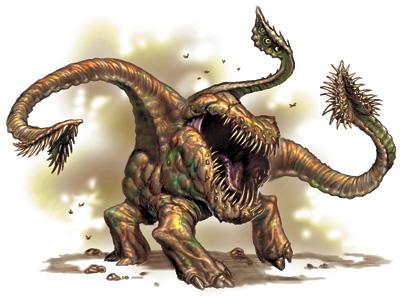 Large Aberration Hit
Dice: 6d8+9 (36 hp) Initiative:
+0 Speed: 20 ft. (4 squares)
Armor Class: 17 (–1 size, +8
natural), touch 9, flat-footed 17 Base
Attack/Grapple: +4/+8 Attack:
Tentacle +4 melee (1d6) Full Attack:
2 tentacles +4 melee
(1d6) and bite –2 melee (1d4) Space/Reach:
10 ft./10 ft. (15
ft. with tentacle) Special Attacks:
Constrict 1d6,
disease, improved grab Special
Qualities: Darkvision 60
ft., scent Saves: Fort +3, Ref
+2, Will +6 Abilities: Str 11,
Dex 10, Con
13, Int 5, Wis 12, Cha 6 Skills:
Hide –1*, Listen +6, Spot
+6 Feats: Alertness, Toughness,
Weapon Focus (tentacle) Environment:
Underground Organization:
Solitary, pair, or
cluster (3–4) Challenge Rating:
4 Treasure: Standard Alignment: Usually neutral Advancement: 7–8 HD (Large); 9–18
HD (Huge) Level Adjustment: —
Large Aberration Hit
Dice: 6d8+9 (36 hp) Initiative:
+0 Speed: 20 ft. (4 squares)
Armor Class: 17 (–1 size, +8
natural), touch 9, flat-footed 17 Base
Attack/Grapple: +4/+8 Attack:
Tentacle +4 melee (1d6) Full Attack:
2 tentacles +4 melee
(1d6) and bite –2 melee (1d4) Space/Reach:
10 ft./10 ft. (15
ft. with tentacle) Special Attacks:
Constrict 1d6,
disease, improved grab Special
Qualities: Darkvision 60
ft., scent Saves: Fort +3, Ref
+2, Will +6 Abilities: Str 11,
Dex 10, Con
13, Int 5, Wis 12, Cha 6 Skills:
Hide –1*, Listen +6, Spot
+6 Feats: Alertness, Toughness,
Weapon Focus (tentacle) Environment:
Underground Organization:
Solitary, pair, or
cluster (3–4) Challenge Rating:
4 Treasure: Standard Alignment: Usually neutral Advancement: 7–8 HD (Large); 9–18
HD (Huge) Level Adjustment: —
A typical otyugh has a body 8 feet in diameter and weighs about 500 pounds.
Otyughs speak Common.
COMBAT
An otyugh attacks living creatures if it feels threatened or if it is hungry; otherwise it is content to remain hidden. Otyughs slash and squeeze opponents with their tentacles, which they also use to drag prey into their mouths.
Constrict (Ex): An otyugh deals automatic tentacle damage with a successful grapple check.
Disease (Ex): Filth fever—bite, Fortitude DC 14, incubation period 1d3 days; damage 1d3 Dex and 1d3 Con. The save DC is Constitution-based.
Improved Grab (Ex): To use this ability, an otyugh must hit with a tentacle attack. It can then attempt to start a grapple as a free action without provoking an attack of opportunity. If it wins the grapple check, it establishes a hold and can constrict.
Skills: *An otyugh has a +8 racial bonus on Hide checks when in its lair, due to its natural coloration.
OWL, GIANT
 Large Magical Beast Hit
Dice: 4d10+4 (26 hp) Initiative:
+3 Speed: 10 ft. (2 squares),
fly 70
ft. (average) Armor Class: 15
(–1 size, +3 Dex,
+3 natural), touch 12, flat-footed 12 Base
Attack/Grapple: +4/+12 Attack:
Claw +7 melee (1d6+4) Full Attack:
2 claws +7 melee
(1d6+4) and bite +2 melee (1d8+2) Space/Reach:
10 ft./5 ft. Special Attacks: —
Special Qualities: Superior
lowlight vision Saves: Fort +5,
Ref +7, Will +3 Abilities: Str
18, Dex 17, Con
12, Int 10, Wis 14, Cha 10 Skills:
Knowledge (nature) +2,
Listen +17, Move Silently +8*, Spot +10 Feats: Alertness, Wingover Environment: Temperate forests Organization: Solitary, pair, or
company (3–5) Challenge Rating:
3 Treasure: None Alignment: Usually neutral good Advancement: 5–8 HD (Large); 9–12
HD (Huge) Level Adjustment: +2
(cohort)
Large Magical Beast Hit
Dice: 4d10+4 (26 hp) Initiative:
+3 Speed: 10 ft. (2 squares),
fly 70
ft. (average) Armor Class: 15
(–1 size, +3 Dex,
+3 natural), touch 12, flat-footed 12 Base
Attack/Grapple: +4/+12 Attack:
Claw +7 melee (1d6+4) Full Attack:
2 claws +7 melee
(1d6+4) and bite +2 melee (1d8+2) Space/Reach:
10 ft./5 ft. Special Attacks: —
Special Qualities: Superior
lowlight vision Saves: Fort +5,
Ref +7, Will +3 Abilities: Str
18, Dex 17, Con
12, Int 10, Wis 14, Cha 10 Skills:
Knowledge (nature) +2,
Listen +17, Move Silently +8*, Spot +10 Feats: Alertness, Wingover Environment: Temperate forests Organization: Solitary, pair, or
company (3–5) Challenge Rating:
3 Treasure: None Alignment: Usually neutral good Advancement: 5–8 HD (Large); 9–12
HD (Huge) Level Adjustment: +2
(cohort)
Giant owls are nocturnal birds of prey, feared for their ability to hunt and attack in near silence. They are intelligent, and though naturally suspicious, sometimes associate with good creatures. A typical giant owl stands about 9 feet tall, has a wingspan of up to 20 feet, and resembles its smaller cousins in nearly every way except size.
Giant owls speak Common and Sylvan.
COMBAT
A giant owl attacks by gliding silently just a few feet above its prey and plunging to strike when directly overhead.
Superior Low-Light Vision (Ex): A giant owl can see five times as far as a human can in dim light.
Skills: Giant owls have a +8 racial bonus on Listen checks and a +4 racial bonus on Spot checks.
*When in flight, giant owls gain a +8 bonus on Move Silently checks.
TRAINING A GIANT OWL
Although intelligent, a giant owl requires training before it can bear a rider in combat. To be trained, a giant owl must have a friendly attitude toward the trainer (this can be achieved through a successful Diplomacy check). Training a friendly giant owl requires six weeks of work and a DC 25 Handle Animal check. Riding a giant owl requires an exotic saddle. A giant owl can fight while carrying a rider, but the rider cannot also attack unless he or she succeeds on a Ride check.
Giant owl eggs are worth 2,500 gp apiece on the open market, while chicks are worth 4,000 gp each. Professional trainers charge 1,000 gp to rear or train a giant owl.
Carrying Capacity: A light load for a giant owl is up to 300 pounds; a medium load, 301–600 pounds; and a heavy load, 601–900 pounds.
OWLBEAR
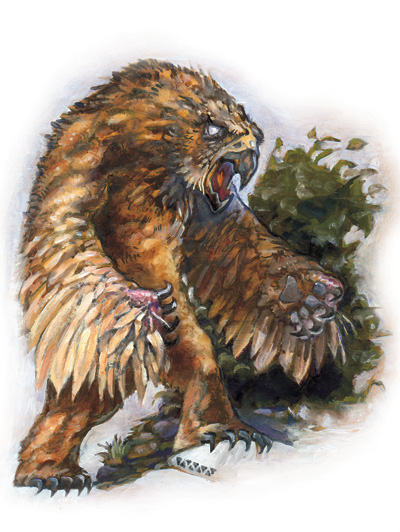 Large Magical Beast Hit
Dice: 5d10+25 (52 hp) Initiative:
+1 Speed: 30 ft. (6 squares)
Armor Class: 15 (–1 size, +1 Dex,
+5 natural), touch 10, flat-footed 14 Base
Attack/Grapple: +5/+14 Attack:
Claw +9 melee (1d6+5) Full Attack:
2 claws +9 melee
(1d6+5) and bite +4 melee (1d8+2) Space/Reach:
10 ft./5 ft. Special Attacks:
Improved grab Special Qualities:
Scent Saves: Fort +9, Ref +5,
Will +2 Abilities: Str 21, Dex
12, Con
21, Int 2, Wis 12, Cha 10 Skills:
Listen +8, Spot +8 Feats:
Alertness, Track Environment:
Temperate forests Organization:
Solitary, pair, or
pack (3–8) Challenge Rating: 4
Treasure: None Alignment: Always neutral Advancement: 6–8 HD (Large); 9–15
HD (Huge) Level Adjustment: —
Large Magical Beast Hit
Dice: 5d10+25 (52 hp) Initiative:
+1 Speed: 30 ft. (6 squares)
Armor Class: 15 (–1 size, +1 Dex,
+5 natural), touch 10, flat-footed 14 Base
Attack/Grapple: +5/+14 Attack:
Claw +9 melee (1d6+5) Full Attack:
2 claws +9 melee
(1d6+5) and bite +4 melee (1d8+2) Space/Reach:
10 ft./5 ft. Special Attacks:
Improved grab Special Qualities:
Scent Saves: Fort +9, Ref +5,
Will +2 Abilities: Str 21, Dex
12, Con
21, Int 2, Wis 12, Cha 10 Skills:
Listen +8, Spot +8 Feats:
Alertness, Track Environment:
Temperate forests Organization:
Solitary, pair, or
pack (3–8) Challenge Rating: 4
Treasure: None Alignment: Always neutral Advancement: 6–8 HD (Large); 9–15
HD (Huge) Level Adjustment: —
An owlbear’s coat ranges in color from brown-black to yellowish brown; its beak is a dull ivory color. A full-grown male can stand as tall as 8 feet and weigh up to 1,500 pounds. Adventurers who have survived encounters with the creature often speak of the bestial madness they glimpsed in its red-rimmed eyes.
COMBAT
Owlbears attack prey—any creature bigger than a mouse—on sight, always fighting to the death. They slash with claws and beak, trying to grab their prey and rip it apart.
Improved Grab (Ex): To use this ability, an owlbear must hit with a claw attack. It can then attempt to start a grapple as a free action without provoking an attack of opportunity.
PEGASUS
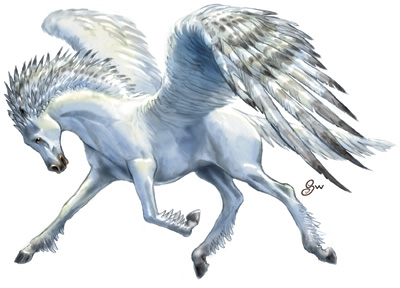 Large Magical Beast Hit
Dice: 4d10+12 (34 hp) Initiative:
+2 Speed: 60 ft. (12 squares),
fly
120 ft. (average) Armor Class:
14 (–1 size, +2 Dex,
+3 natural), touch 11, flat-footed 12 Base
Attack/Grapple: +4/+12 Attack:
Hoof +7 melee (1d6+4) Full Attack:
2 hooves +7 melee
(1d6+4) and bite +2 melee (1d3+2) Space/Reach:
10 ft./5 ft. Special Attacks: —
Special Qualities: Darkvision 60
ft., low-light vision, scent, spell-like abilities Saves: Fort +7, Ref +6, Will +4 Abilities: Str 18, Dex 15, Con
16, Int 10, Wis 13, Cha 13 Skills:
Diplomacy +3, Listen +8,
Sense Motive +9, Spot +8 Feats:
Flyby Attack, Iron Will Environment:
Temperate forests Organization:
Solitary, pair, or
herd (6–10) Challenge Rating: 3
Treasure: None Alignment: Usually chaotic good Advancement: 5–8 HD (Large) Level Adjustment: +2 (cohort)
Large Magical Beast Hit
Dice: 4d10+12 (34 hp) Initiative:
+2 Speed: 60 ft. (12 squares),
fly
120 ft. (average) Armor Class:
14 (–1 size, +2 Dex,
+3 natural), touch 11, flat-footed 12 Base
Attack/Grapple: +4/+12 Attack:
Hoof +7 melee (1d6+4) Full Attack:
2 hooves +7 melee
(1d6+4) and bite +2 melee (1d3+2) Space/Reach:
10 ft./5 ft. Special Attacks: —
Special Qualities: Darkvision 60
ft., low-light vision, scent, spell-like abilities Saves: Fort +7, Ref +6, Will +4 Abilities: Str 18, Dex 15, Con
16, Int 10, Wis 13, Cha 13 Skills:
Diplomacy +3, Listen +8,
Sense Motive +9, Spot +8 Feats:
Flyby Attack, Iron Will Environment:
Temperate forests Organization:
Solitary, pair, or
herd (6–10) Challenge Rating: 3
Treasure: None Alignment: Usually chaotic good Advancement: 5–8 HD (Large) Level Adjustment: +2 (cohort)
The pegasus is a magnificent winged horse that sometimes serves the cause of good. Though highly prized as aerial steeds, pegasi are wild and shy creatures not easily tamed.
A typical pegasus stands 6 feet high at the shoulder, weighs 1,500 pounds, and has a wingspan of 20 feet.
Pegasi cannot speak, but they understand Common.
COMBAT
Spell-Like Abilities: At will—detect good and detect evil within a 60-foot radius. Caster level 5th.
Skills: Pegasi have a +4 racial bonus on Listen and Spot checks.
TRAINING A PEGASUS
Although intelligent, a pegasus requires training before it can bear a rider in combat. To be trained, a pegasus must have a friendly attitude toward the trainer (this can be achieved through a successful Diplomacy check). Training a friendly pegasus requires six weeks of work and a DC 25 Handle Animal check. Riding a pegasus requires an exotic saddle. A pegasus can fight while carrying a rider, but the rider cannot also attack unless he or she succeeds on a Ride check.
Pegasus eggs are worth 2,000 gp each on the open market, while young are worth 3,000 gp per head. Pegasi mature at the same rate as horses. Professional trainers charge 1,000 gp to rear or train a pegasus, which serves a good or neutral master with absolute faithfulness for life.
Carrying Capacity: A light load for a pegasus is up to 300 pounds; a medium load, 301–600 pounds; and a heavy load, 601–900 pounds.
PHANTOM FUNGUS
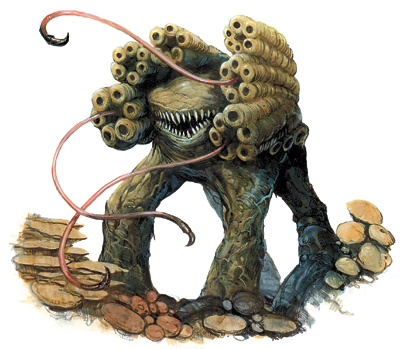 Medium Plant Hit
Dice: 2d8+6 (15 hp) Initiative:
+0 Speed: 20 ft. (4 squares)
Armor Class: 14 (+4 natural),
touch 10, flat-footed 14 Base
Attack/Grapple: +1/+3 Attack:
Bite +3 melee (1d6+3) Full Attack:
Bite +3 melee (1d6+3) Space/Reach:
5 ft./5 ft. Special Attacks: —
Special Qualities: Low-light
vision, plant traits, greater invisibility Saves: Fort +6, Ref +0, Will +0 Abilities: Str 14, Dex 10, Con
16, Int 2, Wis 11, Cha 9 Skills:
Listen +4, Move Silently
+6, Spot +4 Feats: Alertness
Environment: Underground Organization: Solitary Challenge Rating: 3 Treasure: None Alignment: Always neutral Advancement: 3–4 HD (Medium); 5–6
HD (Large) Level Adjustment: —
Medium Plant Hit
Dice: 2d8+6 (15 hp) Initiative:
+0 Speed: 20 ft. (4 squares)
Armor Class: 14 (+4 natural),
touch 10, flat-footed 14 Base
Attack/Grapple: +1/+3 Attack:
Bite +3 melee (1d6+3) Full Attack:
Bite +3 melee (1d6+3) Space/Reach:
5 ft./5 ft. Special Attacks: —
Special Qualities: Low-light
vision, plant traits, greater invisibility Saves: Fort +6, Ref +0, Will +0 Abilities: Str 14, Dex 10, Con
16, Int 2, Wis 11, Cha 9 Skills:
Listen +4, Move Silently
+6, Spot +4 Feats: Alertness
Environment: Underground Organization: Solitary Challenge Rating: 3 Treasure: None Alignment: Always neutral Advancement: 3–4 HD (Medium); 5–6
HD (Large) Level Adjustment: —
This creature looks like a brown and greenish-brown mass with a cluster of nodules atop the main mass, though it is visible only when dead. A cluster of nodules atop the main mass serve as sensory organs. The creature feeds and attacks with a gaping maw lined with rows of teeth. Four stumpy legs support the creature and allow it to move about.
This ambulatory fungus is naturally invisible, making it a feared predator among subterranean inhabitants.
COMBAT
A phantom fungus usually roams quietly, hunting for prey. It attacks lone individuals almost anywhere, but when tackling groups it prefers an open space where it has a better chance .
Greater Invisibility (Su): This ability is constant, allowing a phantom fungus to remain invisible even when attacking. It works like greater invisibility (caster level 12th) and lasts as long as the phantom fungus is alive. This ability is not subject to the invisibility purge spell. A phantom fungus becomes visible 1 minute after it is killed.
Skills: A phantom fungus has a +5 racial bonus on Move Silently checks.
PHASE SPIDER
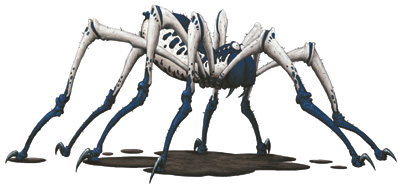 Large Magical Beast Hit
Dice: 5d10+15 (42 hp) Initiative:
+7 Speed: 40 ft. (8 squares),
climb
20 ft. Armor Class: 15 (–1
size, +3 Dex,
+3 natural), touch 12, flat-footed 12 Base
Attack/Grapple: +5/+12 Attack:
Bite +7 melee (1d6+4 plus
poison) Full Attack: Bite +7
melee (1d6+4
plus poison) Space/Reach: 10
ft./5 ft. Special Attacks:
Poison
Large Magical Beast Hit
Dice: 5d10+15 (42 hp) Initiative:
+7 Speed: 40 ft. (8 squares),
climb
20 ft. Armor Class: 15 (–1
size, +3 Dex,
+3 natural), touch 12, flat-footed 12 Base
Attack/Grapple: +5/+12 Attack:
Bite +7 melee (1d6+4 plus
poison) Full Attack: Bite +7
melee (1d6+4
plus poison) Space/Reach: 10
ft./5 ft. Special Attacks:
Poison
Special Qualitiy: Darkvision 60 ft., ethereal jaunt, low-light vision
Saves: Fort +7, Ref +7, Will +2 Abilities: Str 17, Dex 17, Con 16, Int 7, Wis 13, Cha 10 Skills: Climb +11, Move Silently +11, Spot +4 Feats: Ability Focus (poison), Improved Initiative Environment: Warm hills Organization: Solitary or cluster (2–5) Challenge Rating: 5 Treasure: None Alignment: Always neutral Advancement: 6–8 HD (Large); 9–15 HD (Huge) Level Adjustment: —Phase spiders are aggressive predators that can move quickly from the Ethereal Plane to attack opponents on the Material Plane.
A typical phase spider’s body is 8 feet long. It weighs about 700 pounds.
Phase spiders cannot speak.
COMBAT
Phase spiders dwell and hunt on the Material Plane. Once a spider locates prey, however, it shifts to the Ethereal Plane to attack, attempting to catch its victim flat-footed. The spider shifts in, bites its victim, and retreats quickly back to the Ethereal Plane.
Ethereal Jaunt (Su): A phase spider can shift from the Ethereal Plane to the Material Plane as a free action, and shift back again as a move action (or during a move action). The ability is otherwise identical with ethereal jaunt (caster level 15th).
Poison (Ex): Injury, Fortitude DC 17, initial and secondary damage 1d8 Con. The save DC is Constitution-based.
Skills: A phase spider has a +8 racial bonus on Climb checks and can always choose to take 10 on a Climb check, even if rushed or threatened.
PHASM
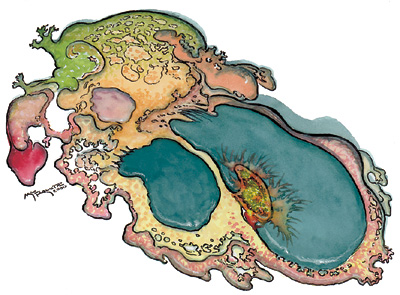 Medium Aberration (Shapechanger) Hit Dice: 15d8+30 (97 hp) Initiative: +6 Speed: 30 ft. (6 squares) Armor Class: 17 (+2 Dex, +5
natural), touch 12, flat-footed 15 Base
Attack/Grapple: +11/+12 Attack:
Slam +12 melee (1d3+1) Full Attack:
Slam +12 melee
(1d3+1) Space/Reach: 5 ft./5 ft.
Special Attacks: — Special Qualities: Alternate
form, amorphous, resilient, scent, telepathy 100 ft., tremorsense 60 ft.
Saves: Fort +11, Ref +11, Will +11
Abilities: Str 12, Dex 15, Con
15, Int 16, Wis 15, Cha 14 Skills:
Bluff
+20, Climb
+7, Craft (any one)
+12, Diplomacy +12, Disguise +20 (+22 acting)*, Intimidate +4,
Knowledge (any one) +18, Listen +12, Spot +12, Survival +8 Feats: Alertness, Blind-Fight,
Combat Reflexes, Dodge, Improved Initiative, Mobility Environment: Underground Organization: Solitary Challenge Rating: 7 Treasure: Standard Alignment: Usually chaotic neutral Advancement: 15–21 HD (Huge);
22–45 HD (Gargantuan) Level
Adjustment: —
Medium Aberration (Shapechanger) Hit Dice: 15d8+30 (97 hp) Initiative: +6 Speed: 30 ft. (6 squares) Armor Class: 17 (+2 Dex, +5
natural), touch 12, flat-footed 15 Base
Attack/Grapple: +11/+12 Attack:
Slam +12 melee (1d3+1) Full Attack:
Slam +12 melee
(1d3+1) Space/Reach: 5 ft./5 ft.
Special Attacks: — Special Qualities: Alternate
form, amorphous, resilient, scent, telepathy 100 ft., tremorsense 60 ft.
Saves: Fort +11, Ref +11, Will +11
Abilities: Str 12, Dex 15, Con
15, Int 16, Wis 15, Cha 14 Skills:
Bluff
+20, Climb
+7, Craft (any one)
+12, Diplomacy +12, Disguise +20 (+22 acting)*, Intimidate +4,
Knowledge (any one) +18, Listen +12, Spot +12, Survival +8 Feats: Alertness, Blind-Fight,
Combat Reflexes, Dodge, Improved Initiative, Mobility Environment: Underground Organization: Solitary Challenge Rating: 7 Treasure: Standard Alignment: Usually chaotic neutral Advancement: 15–21 HD (Huge);
22–45 HD (Gargantuan) Level
Adjustment: —
A phasm is an amorphous creature that can assume the guise of almost any other creature or object. A phasm in its natural form is about 5 feet in diameter and 2 feet high at the center. Swirls of color indicate sensory organs. In this form, a phasm slithers about like an ooze and can attack with a pseudopod. It weighs about 400 pounds.
Phasms can speak Common but prefer telepathic communication.
COMBAT
When faced with potential danger, a phasm is equally likely to retreat, parley, or attack, as its fancy strikes.
If pursued or harassed, a phasm transforms into the most fearsome creature it knows and attacks. When seriously hurt, it changes to some fast or agile form and tries to escape.
Amorphous (Ex): A phasm in its natural form has immunity to poison, sleep, paralysis, polymorph, and stunning effects. It is not subject to critical hits and, having no clear front or back, cannot be flanked.
Resilient (Ex): A phasm has a +4 racial bonus on Fortitude and Reflex saves (included in the statistics block).
Alternate Form (Su): A phasm can assume any form of Large size or smaller as a standard action. This ability functions as a polymorph spell cast on itself (caster level 15th), except that the phasm does not regain hit points for changing form. A phasm can remain in its alternate form until it chooses to assume a new one or return to its natural form.
Tremorsense (Ex): A phasm can automatically sense the location of anything within 60 feet that is in contact with the ground, so long as it is touching the ground itself.
Skills: *When using shapechange, a phasm gains a +10 circumstance bonus on Disguise checks.
PLANETOUCHED
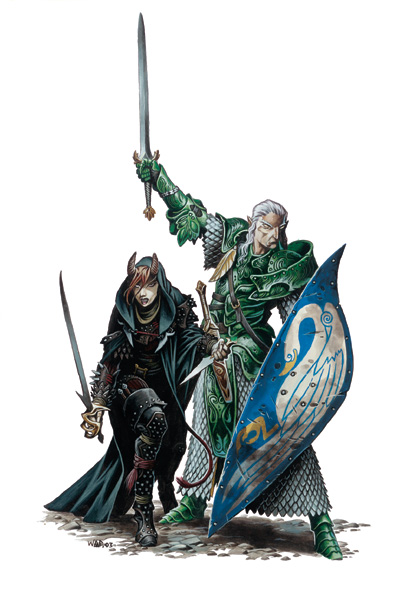
Planetouched is a general word to describe someone who can trace his or her bloodline back to an outsider, usually a fiend or celestial.
The effects of having a supernatural being in one’s heritage last for many generations. Although not as dramatically altered as a half-celestial or a half-fiend, planetouched still retain some special qualities.
The two planetouched varieties described here are the most common. Aasimars are humans with some trace of celestial blood in their veins, and tieflings have some fiendishness in their family tree.
AASIMAR
Aasimar, 1st-Level WarriorMedium Outsider (Native) Hit Dice: 1d8+1 (5 hp) Initiative: +4 Speed: 20 ft. in scale mail (4 squares); base speed 30 ft. Armor Class: 16 (+4 scale mail, +2 heavy shield), touch 10, flat-footed 16 Base Attack/Grapple: +1/+2 Attack: Longsword +2 melee (1d8+1/19–20) or light crossbow +1 ranged (1d8/19–20) Full Attack: Longsword +2 melee (1d8+1/19–20) or light crossbow +1 ranged (1d8/19–20) Space/Reach: 5 ft./5 ft. Special Attacks: Daylight Special Qualities: Darkvision 60 ft., resistance to acid 5, cold 5, and electricity 5 Saves: Fort +3, Ref +0, Will +0 Abilities: Str 13, Dex 11, Con 12, Int 10, Wis 11, Cha 10 Skills: Heal +4, Knowledge (religion) +1, Listen +3, Ride +1, Spot +3 Feats: Improved Initiative Environment: Temperate plains Organization: Solitary, pair, or team (3–4) Challenge Rating: 1/2 Treasure: Standard Alignment: Usually good (any) Advancement: By character class Level Adjustment: +1
Aasimars are usually tall, good-looking, and generally pleasant. Some have a minor physical trait suggesting their heritage, such as silver hair, golden eyes, or an unnaturally intense stare.
Most aasimars are decidedly good-aligned. They fight against evil causes and attempt to sway others to do the right thing. Occasionally they take on the vengeful, judgmental aspect of their celestial ancestor, but this is rare.
Combat
Aasimars usually like a fair, straightforward contest. Against a particularly evil foe, however, they fight with utter conviction and to the death.
Daylight (Sp): An aasimar can use daylight once per day as a 1st-level caster or a caster of his class levels, whichever is higher.
Skills: An aasimar has a +2 racial bonus on Spot and Listen checks.
The aasimar warrior presented here had the following ability scores before racial adjustments: Str 13, Dex 11, Con 12, Int 10, Wis 9, Cha 8.
Aasimar as Characters
Aasimar characters possess the following racial traits.
— +2 Wisdom, +2 Charisma.
—Medium size.
—An aasimar’s base land speed is 30 feet.
—Darkvision: Aasimars can see in the dark up to 60 feet.
—Racial Skills: Aasimars have a +2 racial bonus on Spot and Listen checks.
—Racial Feats: An aasimar gains feats according to its class levels.
—Special Attacks (see above): Daylight.
—Special Qualities (see above): Resistance to acid 5, cold 5, and electricity 5.
—Automatic Languages: Common, Celestial. Bonus Languages: Draconic, Dwarven, Elven, Gnome, Halfling,
Sylvan.
—Favored Class: Paladin.
—Level adjustment +1.
TIEFLING
Tiefling, 1st-Level WarriorMedium Outsider (Native) Hit Dice: 1d8+1 (5 hp) Initiative: +1 Speed: 30 ft. (6 squares) Armor Class: 15 (+1 Dex, +3 studded leather, +1 light shield), touch 11, flat-footed 14 Base Attack/Grapple: +1/+2 Attack: Rapier +3 melee (1d6+1/18–20) or light crossbow +2 ranged (1d8/19–20) Full Attack: Rapier +3 melee (1d6+1/18–20) or light crossbow +2 ranged (1d8/19–20) Space/Reach: 5 ft./5 ft. Special Attacks: Darkness Special Qualities: Darkvision 60 ft., resistance to cold 5, electricity 5, and fire 5 Saves: Fort +3, Ref +1, Will –1 Abilities: Str 13, Dex 13, Con 12, Int 12, Wis 9, Cha 6 Skills: Bluff +4, Hide +5, Move Silently +1, Sleight of Hand +1 Feats: Weapon Focus (rapier) Environment: Temperate plains Organization: Solitary, pair, or gang (3–4) Challenge Rating: 1/2 Treasure: Standard Alignment: Usually evil (any) Advancement: By character class Level Adjustment: +1
Many tieflings are indistinguishable from humans. Others have small horns, pointed teeth, red eyes, a whiff of brimstone about them, or even cloven feet. No two tieflings are the same.
Combat
Tieflings are sneaky, subtle, and generally conniving. They prefer to strike from ambush and usually avoid a fair fight if they can.
Darkness (Sp): A tiefling can use darkness once per day (caster level equal to class levels).
Skills: A tiefling has a +2 racial bonus on Bluff and Hide checks.
The tiefling warrior presented here had the following ability scores before racial adjustments: Str 13, Dex 11, Con 12, Int 10, Wis 9, Cha 8.
Tieflings as Characters
Tiefling characters possess the following racial traits.
— +2 Dexterity, +2 Intelligence, –2 Charisma.
—Medium size.
—A tiefling’s base land speed is 30 feet.
—Darkvision out to 60 feet.
—Racial Skills: Tieflings have a +2 racial bonus on Bluff and Hide checks.
—Racial Feats: A tiefling gains feats according to its class levels.
—Special Attacks (see above): Darkness.
—Special Qualities (see above): Resistance to cold 5, electricity 5, and fire 5.
—Automatic Languages: Common, Infernal. Bonus Languages: Draconic, Dwarven, Elven, Gnome, Goblin, Halfling, Orc.
—Favored Class: Rogue.
—Level adjustment +1.
PSEUDODRAGON
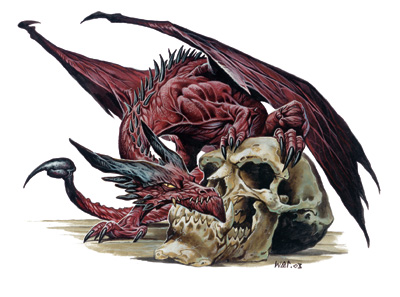 Tiny Dragon Hit
Dice: 2d12+2 (15 hp) Initiative:
+2 Speed: 15 ft. (3 squares),
fly 60
ft. (good) Armor Class: 18 (+2
size, +2 Dex,
+4 natural), touch 14, flat-footed 16 Base
Attack/Grapple: +2/–8 Attack:
Sting +4 melee (1d3–2
plus poison) Full Attack: Sting
+4 melee
(1d3–2 plus poison) and bite –1 melee (1) Space/Reach: 2-1/2 ft./0 ft. (5
ft. with tail) Special Attacks:
Poison Special Qualities:
Blindsense 60
ft., darkvision 60 ft., immunity to sleep and paralysis, low-light
vision, spell resistance 19, telepathy 60 ft. Saves: Fort +4, Ref +5, Will +4 Abilities: Str 6, Dex 15, Con 13,
Int 10, Wis 12, Cha 10 Skills:
Diplomacy +2, Hide +20*,
Listen +7, Search +6, Sense Motive +7, Spot +7, Survival +1 (+3
following tracks) Feats: Weapon
Finesse Environment: Temperate
forests Organization: Solitary,
pair, or
clutch (3–5) Challenge Rating: 1
Treasure: None Alignment: Always neutral good Advancement: 3–4 HD (Tiny) Level Adjustment: +3
Tiny Dragon Hit
Dice: 2d12+2 (15 hp) Initiative:
+2 Speed: 15 ft. (3 squares),
fly 60
ft. (good) Armor Class: 18 (+2
size, +2 Dex,
+4 natural), touch 14, flat-footed 16 Base
Attack/Grapple: +2/–8 Attack:
Sting +4 melee (1d3–2
plus poison) Full Attack: Sting
+4 melee
(1d3–2 plus poison) and bite –1 melee (1) Space/Reach: 2-1/2 ft./0 ft. (5
ft. with tail) Special Attacks:
Poison Special Qualities:
Blindsense 60
ft., darkvision 60 ft., immunity to sleep and paralysis, low-light
vision, spell resistance 19, telepathy 60 ft. Saves: Fort +4, Ref +5, Will +4 Abilities: Str 6, Dex 15, Con 13,
Int 10, Wis 12, Cha 10 Skills:
Diplomacy +2, Hide +20*,
Listen +7, Search +6, Sense Motive +7, Spot +7, Survival +1 (+3
following tracks) Feats: Weapon
Finesse Environment: Temperate
forests Organization: Solitary,
pair, or
clutch (3–5) Challenge Rating: 1
Treasure: None Alignment: Always neutral good Advancement: 3–4 HD (Tiny) Level Adjustment: +3
A pseudodragon has a body about 1 foot long, with a 2-foot tail. It weights about 7 pounds.
A pseudodragon can communicate telepathically and can also vocalize animal noises.
COMBAT
A pseudodragon can deliver a vicious bite, but its principal weapon is its sting-equipped tail.
Poison (Ex): Injury, Fortitude DC 14, initial damage sleep for 1 minute, secondary damage sleep for 1d3 hours. The save DC is Constitution-based and includes a +2 racial bonus.
Blindsense (Ex): A pseudodragon can locate creatures within 60 feet by nonvisual means (mostly hearing and scent, but also by noticing vibration and other environmental clues). Opponents the pseudodragon can’t actually see still have total concealment against the pseudodragon.
Telepathy (Su): Pseudodragons can communicate telepathically with creatures that speak Common or Sylvan, provided they are within 60 feet.
Skills: Pseudodragons have a chameleonlike ability that grants them a +4 racial bonus on Hide checks. *In forests or overgrown areas, this bonus improves to +8.
PURPLE WORM
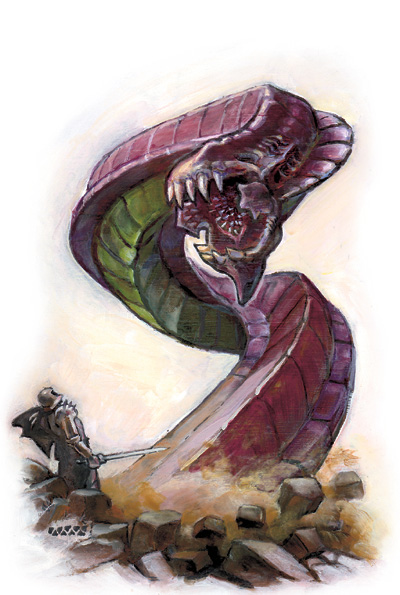 Gargantuan Magical Beast Hit Dice: 16d10+112 (200 hp) Initiative: –2 Speed: 20 ft. (4 squares), burrow
20 ft., swim 10 ft. Armor Class:
19 (–4 size, –2 Dex,
+15 natural), touch 4, flat-footed 19 Base
Attack/Grapple: +16/+40 Attack:
Bite +25 melee (2d8+12) Full Attack:
Bite +25 melee
(2d8+12) and sting +20 melee (2d6+6 plus poison) Space/Reach: 20 ft./15ft. Special Attacks: Improved grab,
swallow whole, poison Special
Qualities: Tremorsense 60
ft. Saves: Fort +17, Ref +8,
Will +4 Abilities: Str 35, Dex
6, Con 25,
Int 1, Wis 8, Cha 8 Skills:
Listen +18, Swim +20 Feats:
Awesome Blow, Cleave,
Improved Bull Rush, Power Attack, Weapon Focus (bite), Weapon Focus
(sting) Environment: Underground
Organization: Solitary Challenge Rating: 12 Treasure: No coins, 50% goods
(stone only), no items Alignment:
Always neutral Advancement:
16–32 HD
(Gargantuan); 33–48 HD (Colossal) Level
Adjustment: —
Gargantuan Magical Beast Hit Dice: 16d10+112 (200 hp) Initiative: –2 Speed: 20 ft. (4 squares), burrow
20 ft., swim 10 ft. Armor Class:
19 (–4 size, –2 Dex,
+15 natural), touch 4, flat-footed 19 Base
Attack/Grapple: +16/+40 Attack:
Bite +25 melee (2d8+12) Full Attack:
Bite +25 melee
(2d8+12) and sting +20 melee (2d6+6 plus poison) Space/Reach: 20 ft./15ft. Special Attacks: Improved grab,
swallow whole, poison Special
Qualities: Tremorsense 60
ft. Saves: Fort +17, Ref +8,
Will +4 Abilities: Str 35, Dex
6, Con 25,
Int 1, Wis 8, Cha 8 Skills:
Listen +18, Swim +20 Feats:
Awesome Blow, Cleave,
Improved Bull Rush, Power Attack, Weapon Focus (bite), Weapon Focus
(sting) Environment: Underground
Organization: Solitary Challenge Rating: 12 Treasure: No coins, 50% goods
(stone only), no items Alignment:
Always neutral Advancement:
16–32 HD
(Gargantuan); 33–48 HD (Colossal) Level
Adjustment: —
The body of a mature purple worm is 5 feet in diameter and 80 feet long, weighing about 40,000 pounds. The creature has a poisonous stinger in its tail.
COMBAT
In battle, a purple worm forms into a coil 20 feet in diameter, biting and stinging anything within reach.
Improved Grab (Ex): To use this ability, a purple worm must hit with its bite attack. It can then attempt to start a grapple as a free action without provoking an attack of opportunity. If it wins the grapple check, it establishes a hold and can attempt to swallow the foe the following round.
Poison (Ex): Injury, Fortitude DC 25, initial damage 1d6 Str, secondary damage 2d6 Str. The save DC is Constitution-based.
Swallow Whole (Ex): A purple worm can try to swallow a grabbed opponent of a smaller size than itself by making a successful grapple check. Once inside, the opponent takes 2d8+12 points of crushing damage plus 8 points of acid damage per round from the worm’s gizzard. A swallowed creature can cut its way out by using a light slashing or piercing weapon to deal 25 points of damage to the gizzard (AC 17). Once the creature exits, muscular action closes the hole; another swallowed opponent must cut its own way out. A Gargantuan worm’s interior can hold 2 Large, 8 Medium, 32 Small, 128 Tiny, or 512 Diminutive or smaller opponents.
Skills: A purple worm has a +8 racial bonus on any Swim check to perform some special action or avoid a hazard. It can always choose to take 10 on a Swim check, even if distracted or endangered. It can use the run action while swimming, provided it swims in a straight line.
RAKSHASA
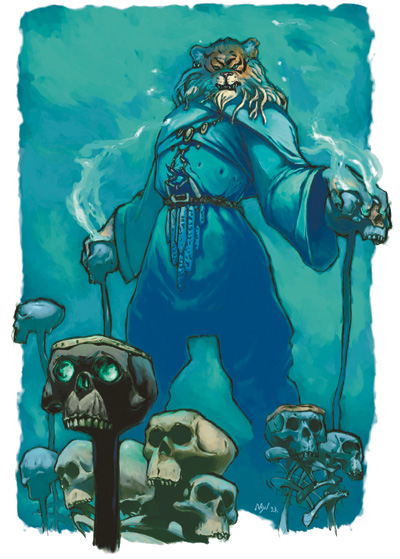 Medium Outsider (Native) Hit Dice: 7d8+21 (52 hp) Initiative: +2 Speed: 40 ft. (8 squares) Armor Class: 21 (+2 Dex, +9
natural), touch 12, flat-footed 19 Base
Attack/Grapple: +7/+8 Attack:
Claw +8 melee (1d4+1) Full Attack:
2 claws +8 melee
(1d4+1) and bite +3 melee (1d6) Space/Reach:
5 ft./5 ft. Special Attacks:
Detect thoughts,
spells Special Qualities:
Change shape,
damage reduction 15/good and piercing, darkvision 60 ft., spell
resistance 27 Saves: Fort +8,
Ref +7, Will +6 Abilities: Str
12, Dex 14, Con
16, Int 13, Wis 13, Cha 17 Skills:
Bluff
+17*, Concentration +13,
Diplomacy +7, Disguise +17 (+19 acting)*, Intimidate +5, Listen +13,
Move Silently +13, Perform (oratory) +13, Sense Motive +11, Spellcraft
+11, Spot +11 Feats: Alertness,
Combat Casting,
Dodge Environment: Warm marshes
Organization: Solitary Challenge Rating: 10 Treasure: Standard coins; double
goods; standard items Alignment:
Always lawful evil Advancement:
By character class Level Adjustment:
+7
Medium Outsider (Native) Hit Dice: 7d8+21 (52 hp) Initiative: +2 Speed: 40 ft. (8 squares) Armor Class: 21 (+2 Dex, +9
natural), touch 12, flat-footed 19 Base
Attack/Grapple: +7/+8 Attack:
Claw +8 melee (1d4+1) Full Attack:
2 claws +8 melee
(1d4+1) and bite +3 melee (1d6) Space/Reach:
5 ft./5 ft. Special Attacks:
Detect thoughts,
spells Special Qualities:
Change shape,
damage reduction 15/good and piercing, darkvision 60 ft., spell
resistance 27 Saves: Fort +8,
Ref +7, Will +6 Abilities: Str
12, Dex 14, Con
16, Int 13, Wis 13, Cha 17 Skills:
Bluff
+17*, Concentration +13,
Diplomacy +7, Disguise +17 (+19 acting)*, Intimidate +5, Listen +13,
Move Silently +13, Perform (oratory) +13, Sense Motive +11, Spellcraft
+11, Spot +11 Feats: Alertness,
Combat Casting,
Dodge Environment: Warm marshes
Organization: Solitary Challenge Rating: 10 Treasure: Standard coins; double
goods; standard items Alignment:
Always lawful evil Advancement:
By character class Level Adjustment:
+7
A closer look at a rakshasa reveals that the palms of its hands are where the backs of the hands would be on a human.
A rakshasa is about the same height and weight as a human.
Rakshasas speak Common, Infernal, and Undercommon.
COMBAT
In close combat, which a rakshasa disdains as ignoble, it employs its sharp claws and powerful bite. Whenever possible, it uses its other abilities to make such encounters unnecessary.
Detect Thoughts (Su): A rakshasa can continuously use detect thoughts as the spell (caster level 18th; Will DC 15 negates). It can suppress or resume this ability as a free action. The save DC is Charisma-based.
Spells: A rakshasa casts spells as a 7th-level sorcerer.
Typical Sorcerer Spells Known (6/7/7/5; save DC 13 + spell level): 0—detect magic, light, mage hand, message, read magic, resistance, touch of fatigue; 1st—charm person, mage armor, magic missile, shield, silent image; 2nd—bear’s endurance, invisibility, acid arrow; 3rd—haste, suggestion.
Change Shape (Su): A rakshasa can assume any humanoid form, or revert to its own form, as a standard action. In humanoid form, a rakshasa loses its claw and bite attacks (although it often equips itself with weapons and armor instead). A rakshasa remains in one form until it chooses to assume a new one. A change in form cannot be dispelled, but the rakshasa reverts to its natural form when killed. A true seeing spell reveals its natural form.
Skills: A rakshasa has a +4 racial bonus on Bluff and Disguise checks. *When using change shape, a rakshasa gains an additional +10 circumstance bonus on Disguise checks. If reading an opponent’s mind, its circumstance bonus on Bluff and Disguise checks increases by a further +4.
RAKSHASAS AS CHARACTERS
Rakshasa characters possess the following racial traits.
— +2 Strength, +4 Dexterity, +6 Constitution, +2 Intelligence, +2 Wisdom, +6 Charisma.
—Medium size.
—A rakshasa’s base land speed is 40 feet.
—Darkvision out to 60 feet.
—Racial Hit Dice: A rakshasa begins with seven levels of outsider, which provide 7d8 Hit Dice, a base attack bonus of +7, and base saving throw bonuses of Fort +5, Ref +5, and Will +5.
—Racial Skills: A rakshasa’s outsider levels give it skill points equal to 10 x (8 + Int modifier). Its class skills are Bluff, Disguise, Listen, Move Silently, Perform, Sense Motive, and Spot. A rakshasa has a +4 racial bonus on Bluff and Disguise checks, and it can gain further bonuses by using change shape (+10 on Disguise checks) and detect thoughts (+4 on Bluff and Disguise checks).
—Racial Feats: A rakshasa’s outsider levels give it three feats.
— +9 natural armor bonus.
—Natural Weapons: Bite (1d6) and 2 claws (1d4).
—Detect Thoughts (Su): The save DC is 13 + the character’s Cha modifier.
—Spells: A rakshasa character casts spells as a 7th-level sorcerer. If the character takes additional levels of sorcerer, these levels stack with the rakshasa’s base spellcasting ability for spells known, spells per day, and other effects dependent on caster level. A rakshasa character likewise uses the sum of its
racial spellcasting levels and class levels to determine the abilities
of its familiar.
—Special Qualities (see above): Change shape, damage reduction 15/good and piercing, spell resistance equal to 27 + class levels.
—Automatic Languages: Common, Infernal. Bonus Languages: Sylvan, Undercommon.
—Favored Class: Sorcerer.
—Level adjustment +7.
RAST
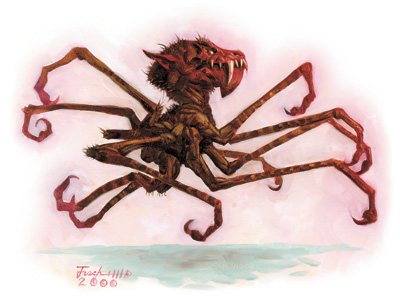 Medium Outsider (Extraplanar, Fire) Hit Dice: 4d8+7 (25 hp) Initiative: +5 Speed: 5 ft. (1 square), fly 60
ft. (good) Armor Class: 15 (+1
Dex, +4
natural), touch 11, flat-footed 14 Base
Attack/Grapple: +4/+6 Attack:
Claw +6 melee (1d4+2) or
bite +6 melee (1d8+3) Full Attack:
4 claws +6 melee
(1d4+2) or bite +6 melee (1d8+3) Space/Reach:
5 ft./5 ft. Special Attacks:
Paralyzing gaze,
improved grab, blood drain Special
Qualities: Darkvision 60
ft., flight, immunity to fire, vulnerability to cold Saves: Fort +5, Ref +5, Will +5 Abilities: Str 14, Dex 12, Con
13, Int 3, Wis 13, Cha 12 Skills:
Hide +8, Listen +8, Move
Silently +8, Spot +8 Feats:
Improved Initiative,
Toughness Environment:
Elemental Plane of
Fire Organization: Solitary,
pair, or
cluster (3–6) Challenge Rating:
5 Treasure: None Alignment: Usually neutral Advancement: 5–6 HD (Medium);
7–12 HD (Large) Level Adjustment:
—
Medium Outsider (Extraplanar, Fire) Hit Dice: 4d8+7 (25 hp) Initiative: +5 Speed: 5 ft. (1 square), fly 60
ft. (good) Armor Class: 15 (+1
Dex, +4
natural), touch 11, flat-footed 14 Base
Attack/Grapple: +4/+6 Attack:
Claw +6 melee (1d4+2) or
bite +6 melee (1d8+3) Full Attack:
4 claws +6 melee
(1d4+2) or bite +6 melee (1d8+3) Space/Reach:
5 ft./5 ft. Special Attacks:
Paralyzing gaze,
improved grab, blood drain Special
Qualities: Darkvision 60
ft., flight, immunity to fire, vulnerability to cold Saves: Fort +5, Ref +5, Will +5 Abilities: Str 14, Dex 12, Con
13, Int 3, Wis 13, Cha 12 Skills:
Hide +8, Listen +8, Move
Silently +8, Spot +8 Feats:
Improved Initiative,
Toughness Environment:
Elemental Plane of
Fire Organization: Solitary,
pair, or
cluster (3–6) Challenge Rating:
5 Treasure: None Alignment: Usually neutral Advancement: 5–6 HD (Medium);
7–12 HD (Large) Level Adjustment:
—
A rast has anywhere from ten to fifteen claws, though it can only use four at once.
A rast has a body about the size of a large dog’s, with a head almost as large as the body. It weighs about 200 pounds.
COMBAT
Rasts paralyze as many of their foes as possible, then attack any that are still moving. A rast can claw or bite, but cannot do both during the same round.
Paralyzing Gaze (Su): Paralysis for 1d6 rounds, 30 feet, Fortitude DC 13 negates. The save DC is Charisma-based.
Improved Grab (Ex): To use this ability, a rast must hit with its bite attack. It can then attempt to start a grapple as a free action without provoking an attack of opportunity.
Blood Drain (Ex): A rast drains blood from a grabbed opponent, dealing 1 point of Constitution damage each round it maintains the hold.
Flight (Su): A rast can cease or resume flight as a free action. A rast that loses this ability falls and can perform only a single action (either a move action or an attack action) each round.
RAVID
 Medium Outsider (Extraplanar) Hit Dice: 3d8+3 (16 hp) Initiative: +4 Speed: 20 ft. (4 squares), fly 60
ft. (perfect) Armor Class: 25
(+15 natural),
touch 10, flat-footed 25 Base
Attack/Grapple: +3/+4 Attack:
Tail slap +4 melee (1d6+1
plus positive energy) or tail touch +4 melee touch (positive energy)
Full Attack: Tail slap +4 melee
(1d6+1 plus positive energy) and claw +2 melee (1d4 plus positive
energy); or tail touch +4 melee touch (positive energy) and claw touch
+2 melee touch (positive energy) Space/Reach:
5 ft./5 ft. Special Attacks:
Positive energy
lash, animate objects Special
Qualities: Darkvision 60
ft., flight, immunity to fire Saves:
Fort +4, Ref +3, Will +4 Abilities:
Str 13, Dex 10, Con
13, Int 7, Wis 12, Cha 14 Skills:
Escape Artist +6, Hide
+6, Listen +7, Move Silently +6, Spot +7, Survival +7, Use Rope +0 (+2
with bindings) Feats: Improved
Initiative,
Multiattack Environment:
Positive Energy Plane Organization:
Solitary (1 plus at
least 1 animated object) Challenge
Rating: 5 Treasure: None
Alignment: Always neutral Advancement: 4 HD (Medium); 5–9
HD (Large) Level Adjustment: —
Medium Outsider (Extraplanar) Hit Dice: 3d8+3 (16 hp) Initiative: +4 Speed: 20 ft. (4 squares), fly 60
ft. (perfect) Armor Class: 25
(+15 natural),
touch 10, flat-footed 25 Base
Attack/Grapple: +3/+4 Attack:
Tail slap +4 melee (1d6+1
plus positive energy) or tail touch +4 melee touch (positive energy)
Full Attack: Tail slap +4 melee
(1d6+1 plus positive energy) and claw +2 melee (1d4 plus positive
energy); or tail touch +4 melee touch (positive energy) and claw touch
+2 melee touch (positive energy) Space/Reach:
5 ft./5 ft. Special Attacks:
Positive energy
lash, animate objects Special
Qualities: Darkvision 60
ft., flight, immunity to fire Saves:
Fort +4, Ref +3, Will +4 Abilities:
Str 13, Dex 10, Con
13, Int 7, Wis 12, Cha 14 Skills:
Escape Artist +6, Hide
+6, Listen +7, Move Silently +6, Spot +7, Survival +7, Use Rope +0 (+2
with bindings) Feats: Improved
Initiative,
Multiattack Environment:
Positive Energy Plane Organization:
Solitary (1 plus at
least 1 animated object) Challenge
Rating: 5 Treasure: None
Alignment: Always neutral Advancement: 4 HD (Medium); 5–9
HD (Large) Level Adjustment: —
Ravids are creatures from the Positive Energy Plane. These bizarre entities imbue creatures with energy by their touch and animate lifeless objects around them. Ravids that make their way to the Material Plane wander about aimlessly, followed by the objects to which they have given life.
A ravid is about 7 feet long and weighs about 75 pounds.
COMBAT
Ravids fight only in self-defense. A ravid itself is not very powerful but is always accompanied by at least one animated object that defends it.
Positive Energy Lash (Su): A ravid can make a touch attack or hit with a claw or tail slap attack to infuse a target with positive energy. The energy produces an unpleasant tingle in living creatures, and against undead foes (even incorporeal ones) it deals 2d10 points of damage.
Animate Objects (Su): Once per round, a random object within 20 feet of a ravid animates as though by the spell animate objects (caster level 20th). These objects defend the ravid to the best of their ability, but the ravid isn’t intelligent enough to employ elaborate tactics with them.
Flight (Su): A ravid can cease or resume flight as a free action. A rast that loses this ability falls and can perform only a single action (either a move action or an attack action) each round.
Feats: A ravid has the Multiattack feat even through it does not have the requisite three natural weapons.
REMORHAZ
 Huge Magical Beast Hit
Dice: 7d10+35 (73 hp) Initiative:
+1 Speed: 30 ft. (6 squares),
burrow
20 ft. Armor Class: 20 (–2
size, +1 Dex,
+11 natural), touch 9, flat-footed 19 Base
Attack/Grapple: +7/+23 Attack:
Bite +13 melee (2d8+12) Full Attack:
Bite +13 melee
(2d8+12) Space/Reach: 15 ft./10
ft. Special Attacks: Improved
grab,
swallow whole Special Qualities:
Darkvision 60
ft., heat, low-light vision, tremorsense 60 ft. Saves: Fort +10, Ref +6, Will +3 Abilities: Str 26, Dex 13, Con
21, Int 5, Wis 12, Cha 10 Skills:
Listen +8, Spot +8 Feats:
Awesome Blow, Improved
Bull Rush, Power Attack Environment:
Cold desert Organization:
Solitary Challenge Rating: 7
Treasure: None Alignment: Usually neutral Advancement: 8–14 HD (Huge);
15–21 HD (Gargantuan) Level
Adjustment: —
Huge Magical Beast Hit
Dice: 7d10+35 (73 hp) Initiative:
+1 Speed: 30 ft. (6 squares),
burrow
20 ft. Armor Class: 20 (–2
size, +1 Dex,
+11 natural), touch 9, flat-footed 19 Base
Attack/Grapple: +7/+23 Attack:
Bite +13 melee (2d8+12) Full Attack:
Bite +13 melee
(2d8+12) Space/Reach: 15 ft./10
ft. Special Attacks: Improved
grab,
swallow whole Special Qualities:
Darkvision 60
ft., heat, low-light vision, tremorsense 60 ft. Saves: Fort +10, Ref +6, Will +3 Abilities: Str 26, Dex 13, Con
21, Int 5, Wis 12, Cha 10 Skills:
Listen +8, Spot +8 Feats:
Awesome Blow, Improved
Bull Rush, Power Attack Environment:
Cold desert Organization:
Solitary Challenge Rating: 7
Treasure: None Alignment: Usually neutral Advancement: 8–14 HD (Huge);
15–21 HD (Gargantuan) Level
Adjustment: —
A remorhaz is whitish-blue in color but pulses with a reddish glow from the heat its body produces. The creature is a little more than 20 feet long, with a body about 5 feet wide. It weighs about 10,000 pounds.
Remorhazes cannot speak.
COMBAT
Remorhazes hide under the snow and ice until they hear movement above them, then attack from below and surprise prey.
Improved Grab (Ex): To use this ability, a remorhaz must hit an opponent least one size category smaller than itself with its bite attack. It can then attempt to start a grapple as a free action without provoking an attack of opportunity. If it wins the grapple check, it establishes a hold and can attempt to swallow the opponent the following round.
Swallow Whole (Ex): When a remorhaz begins its turn with a grappled opponent in its mouth, it can swallow that opponent with a successful grapple check. Once inside, the opponent takes 2d8+12 points of bludgeoning damage plus 8d6 points of fire damage per round from the remorhaz’s gizzard. A swallowed creature can cut its way out by using a light slashing or piercing weapon to deal 25 points of damage to the gizzard (AC 15). Once the creature exits, muscular action closes the hole; another swallowed opponent must cut its own way out. A Huge remorhaz’s interior can hold 2 Large, 4 Medium, 8 Small, 32 Tiny, 128 Diminutive, or 512 Fine or smaller opponents.
Heat (Ex): An enraged remorhaz generates heat so intense that anything touching its body takes 8d6 points of fire damage. Creatures striking a remorhaz with natural attacks or unarmed attacks are subject to this damage, but creatures striking with melee weapons do not take damage from the remorhaz’s heat. This heat can melt or char weapons; any weapon that strikes a remorhaz is allowed a DC 18 Fortitude save to avoid destruction. The save DC is Constitution-based.
Skills: Remorhazes have a +4 racial bonus on Listen checks.
ROC
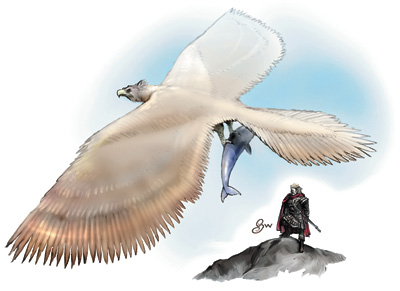 Gargantuan Animal Hit
Dice: 18d8+126 (207 hp) Initiative:
+2 Speed: 20 ft. (4 squares),
fly 80
ft. (average) Armor Class: 17
(–4 size, +2 Dex,
+9 natural), touch 8, flatfooted 15 Base
Attack/Grapple: +13/+37 Attack:
Talon +21 melee (2d6+12) Full Attack:
2 talons +21 melee
(2d6+12) and bite +19 melee (2d8+6) Space/Reach:
20 ft./15 ft. Special Attacks: —
Special Qualities: Low-light
vision Saves: Fort +18, Ref
+13, Will +9 Abilities: Str 34,
Dex 15, Con
24, Int 2, Wis 13, Cha 11 Skills:
Hide –3, Listen +10, Spot
+14 Feats: Alertness, Flyby
Attack,
Iron Will, Multiattack, Power Attack, Snatch, Wingover Environment: Warm mountains Organization: Solitary or pair Challenge Rating: 9 Treasure: None Alignment: Always neutral Advancement: 19–32 HD
(Gargantuan); 33–54 (Colossal) Level
Adjustment: —
Gargantuan Animal Hit
Dice: 18d8+126 (207 hp) Initiative:
+2 Speed: 20 ft. (4 squares),
fly 80
ft. (average) Armor Class: 17
(–4 size, +2 Dex,
+9 natural), touch 8, flatfooted 15 Base
Attack/Grapple: +13/+37 Attack:
Talon +21 melee (2d6+12) Full Attack:
2 talons +21 melee
(2d6+12) and bite +19 melee (2d8+6) Space/Reach:
20 ft./15 ft. Special Attacks: —
Special Qualities: Low-light
vision Saves: Fort +18, Ref
+13, Will +9 Abilities: Str 34,
Dex 15, Con
24, Int 2, Wis 13, Cha 11 Skills:
Hide –3, Listen +10, Spot
+14 Feats: Alertness, Flyby
Attack,
Iron Will, Multiattack, Power Attack, Snatch, Wingover Environment: Warm mountains Organization: Solitary or pair Challenge Rating: 9 Treasure: None Alignment: Always neutral Advancement: 19–32 HD
(Gargantuan); 33–54 (Colossal) Level
Adjustment: —
A roc’s plumage is either dark brown or golden from head to tail. These enormous creatures are 30 feet long from the beak to the base of the tail, with wingspans as wide as 80 feet. A roc weighs about 8,000 pounds.
COMBAT
A roc attacks from the air, swooping earthward to snatch prey in its powerful talons and carry it off for itself and its young to devour. A solitary roc is typically hunting and will attack any Medium or larger creature that appears edible. A mated pair of rocs attack in concert, fighting to the death to defend their nests or hatchlings.
Skills: Rocs have a +4 racial bonus on Spot checks.
ROPER
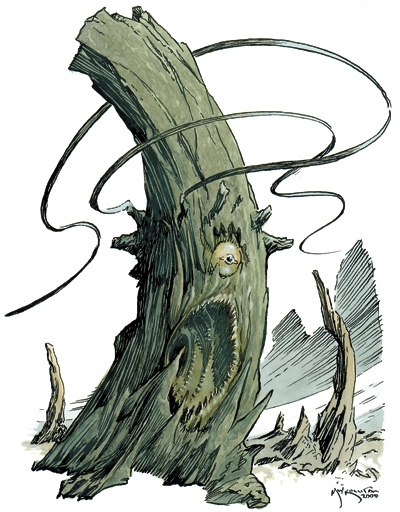 Large Magical Beast Hit
Dice: 10d10+30 (85 hp) Initiative:
+5 Speed: 10 ft. (2 squares)
Armor Class: 24 (–1 size, +1 Dex,
+14 natural), touch 10, flat-footed 23 Base
Attack/Grapple: +10/+18 Attack:
Strand +11 ranged touch
(drag) or bite +13 melee (2d6+6) Full
Attack: 6 strands +11 ranged
touch (drag) and bite +13 melee (2d6+6) Space/Reach:
10 ft./10 ft. (50
ft. with strand) Special Attacks:
Drag, strands,
weakness Special Qualities:
Darkvision 60
ft., immunity to electricity, low-light vision, resistance to cold 10,
spell resistance 30, vulnerability to fire Saves: Fort +10, Ref +8, Will +8 Abilities: Str 19, Dex 13, Con
17, Int 12, Wis 16, Cha 12 Skills:
Climb
+12, Hide +10*,
Listen +13, Spot +13 Feats:
Alertness, Improved
Initiative, Iron Will, Weapon Focus (strand) Environment: Underground Organization: Solitary, pair, or
cluster (3–6) Challenge Rating:
12 Treasure: No coins; 50%
goods
(stone only); no items Alignment:
Usually chaotic evil Advancement:
11–15 HD (Large);
16–30 HD (Huge) Level Adjustment:
—
Large Magical Beast Hit
Dice: 10d10+30 (85 hp) Initiative:
+5 Speed: 10 ft. (2 squares)
Armor Class: 24 (–1 size, +1 Dex,
+14 natural), touch 10, flat-footed 23 Base
Attack/Grapple: +10/+18 Attack:
Strand +11 ranged touch
(drag) or bite +13 melee (2d6+6) Full
Attack: 6 strands +11 ranged
touch (drag) and bite +13 melee (2d6+6) Space/Reach:
10 ft./10 ft. (50
ft. with strand) Special Attacks:
Drag, strands,
weakness Special Qualities:
Darkvision 60
ft., immunity to electricity, low-light vision, resistance to cold 10,
spell resistance 30, vulnerability to fire Saves: Fort +10, Ref +8, Will +8 Abilities: Str 19, Dex 13, Con
17, Int 12, Wis 16, Cha 12 Skills:
Climb
+12, Hide +10*,
Listen +13, Spot +13 Feats:
Alertness, Improved
Initiative, Iron Will, Weapon Focus (strand) Environment: Underground Organization: Solitary, pair, or
cluster (3–6) Challenge Rating:
12 Treasure: No coins; 50%
goods
(stone only); no items Alignment:
Usually chaotic evil Advancement:
11–15 HD (Large);
16–30 HD (Huge) Level Adjustment:
—
A roper stands some 9 feet tall and tapers from 3 or 4 feet in diameter at the base to 1 foot across at the top. It weighs 2,200 pounds. A roper’s coloration and temperature change to match the features of the surrounding cave.
Ropers speak Terran and Undercommon.
COMBAT
A roper hunts by standing very still and imitating a bit of rock. This tactic often allows it to attack with surprise. When prey comes within reach, it lashes out with its strands. In melee, it bites adjacent opponents with its powerful maw.
Drag (Ex): If a roper hits with a strand attack, the strand latches onto the opponent’s body. This deals no damage but drags the stuck opponent 10 feet closer each subsequent round (provoking no attack of opportunity) unless that creature breaks free, which requires a DC 23 Escape Artist check or a DC 19 Strength check. The check DCs are Strength-based, and the Escape Artist DC includes a +4 racial bonus. A roper can draw in a creature within 10 feet of itself and bite with a +4 attack bonus in the same round.
A strand has 10 hit points and can be attacked by making a successful sunder attempt. However, attacking a roper’s strand does not provoke an attack of opportunity. If the strand is currently attached to a target, the roper takes a –4 penalty on its opposed attack roll to resist the sunder attempt. Severing a strand deals no damage to a roper.
Strands (Ex): Most encounters with a roper begin when it fires strong, sticky strands. The creature can have up to six strands at once, and they can strike up to 50 feet away (no range increment). If a strand is severed, the roper can extrude a new one on its next turn as a free action.
Weakness (Ex): A roper’s strands can sap an opponent’s strength. Anyone grabbed by a strand must succeed on a DC 18 Fortitude save or take 2d8 points of Strength damage. The save DC is Constitution-based.
Skills: *Ropers have a +8 racial bonus on Hide checks in stony or icy areas.
RUST MONSTER
 Medium Aberration Hit
Dice: 5d8+5 (27 hp) Initiative:
+3 Speed: 40 ft. (8 squares)
Armor Class: 18 (+3 Dex, +5
natural), touch 13, flat-footed 15 Base
Attack/Grapple: +3/+3 Attack:
Antennae touch +3 melee
(rust) Full Attack: Antennae
touch +3
melee (rust) and bite –2 melee (1d3) Space/Reach:
5 ft./5 ft. Special Attacks:
Rust Special Qualities:
Darkvision,
scent Saves: Fort +2, Ref +4,
Will +5 Abilities: Str 10, Dex
17, Con
13, Int 2, Wis 13, Cha 8 Skills:
Listen +7, Spot +7 Feats:
Alertness, Track Environment:
Underground Organization:
Solitary or pair Challenge Rating:
3 Treasure: None Alignment: Always neutral Advancement: 6–8 HD (Medium);
9–15 HD (Large) Level Adjustment:
—
Medium Aberration Hit
Dice: 5d8+5 (27 hp) Initiative:
+3 Speed: 40 ft. (8 squares)
Armor Class: 18 (+3 Dex, +5
natural), touch 13, flat-footed 15 Base
Attack/Grapple: +3/+3 Attack:
Antennae touch +3 melee
(rust) Full Attack: Antennae
touch +3
melee (rust) and bite –2 melee (1d3) Space/Reach:
5 ft./5 ft. Special Attacks:
Rust Special Qualities:
Darkvision,
scent Saves: Fort +2, Ref +4,
Will +5 Abilities: Str 10, Dex
17, Con
13, Int 2, Wis 13, Cha 8 Skills:
Listen +7, Spot +7 Feats:
Alertness, Track Environment:
Underground Organization:
Solitary or pair Challenge Rating:
3 Treasure: None Alignment: Always neutral Advancement: 6–8 HD (Medium);
9–15 HD (Large) Level Adjustment:
—
The hide of these creatures varies in color from a yellowish tan underside to a rust-red upper back. A rust monster’s prehensile antennae can rust metals on contact.
The typical rust monster measures 5 feet long and 3 feet high, weighing 200 pounds.
COMBAT
A rust monster can scent a metal object from up to 90 feet away. When it detects one, it dashes toward the source and attempts to strike it with its antennae. The creature is relentless, chasing characters over long distances if they still possess intact metal objects but usually ceasing its attacks to devour a freshly rusted meal.
The creature targets the largest metal object available, striking first at armor, then at shields and smaller items. It prefers ferrous metals (steel or iron) over precious metals (such as gold or silver) but will devour the latter if given the opportunity.
Rust (Ex): A rust monster that makes a successful touch attack with its antennae causes the target metal to corrode, falling to pieces and becoming useless immediately. The touch can destroy up to a 10-foot cube of metal instantly. Magic armor and weapons, and other magic items made of metal, must succeed on a DC 17 Reflex save or be dissolved. The save DC is Constitution-based and includes a +4 racial bonus.
A metal weapon that deals damage to a rust monster corrodes immediately. Wooden, stone, and other nonmetallic weapons are unaffected.